Abstract
We used an immunosuppressed rat model to test the hypothesis that normal mechanisms regulating surfactant phosphatidylcholine synthesis and secretion in alveolar type II cells are aberrant in Pneumocystis carinii pneumonia. Animal groups included: group 1, healthy controls; group 2, immunosuppressed, without pneumocystosis; group 3, immunosuppressed with pneumocystosis; group 4, immunosuppressed with well-established pneumocystosis treated with trimethoprim-sulfamethoxazole (TMP-SMX). Type II cells were isolated from rats in each group and compared for [3H]choline incorporation into phospholipid and response of the type II cells to secretagogues. Incorporation of [3H]choline into phospholipid subclasses exhibited significant differences. Incorporation into phosphatidylcholine fell from 89.3 +/- 2.2% of total incorporation in group 1 control rats to 79.6 +/- 3.1% in group 3 rats with P. carinii pneumonia, while incorporation into sphingomyelin rose from 5.6 +/- 1.2% in group 1 animals to 15.2 +/- 2.7% in group 3 rats. Incorporation of [3H]choline into phospholipid subclasses in cells from group 2 and group 4 animals was not different from incorporation for group 1 animals. Type II cells from group 1 and group 2 (immunosuppressed control) rats responded appropriately to the secretagogues ATP, TPA, and terbutaline with a marked increase in surfactant phosphatidylcholine secretion; the effect of ATP was also blocked by the lectin, concanavalin A. In contrast, type II cells from group 3 rats failed to respond to the secretagogues with a significant increase in phospholipid secretion. Although treatment of group 4 rats with TMP-SMX markedly reduced the P. carinii organism burden, type II cells from these animals also responded poorly to the secretagogues. The depressed type II cell function described here provides a mechanism for the observed decrease in surfactant phospholipids from bronchoalveolar lavage fluid of experimental animals and patients with P. carinii pneumonia. The data also suggest this defect may become irreversible with advanced disease.
Full text
PDF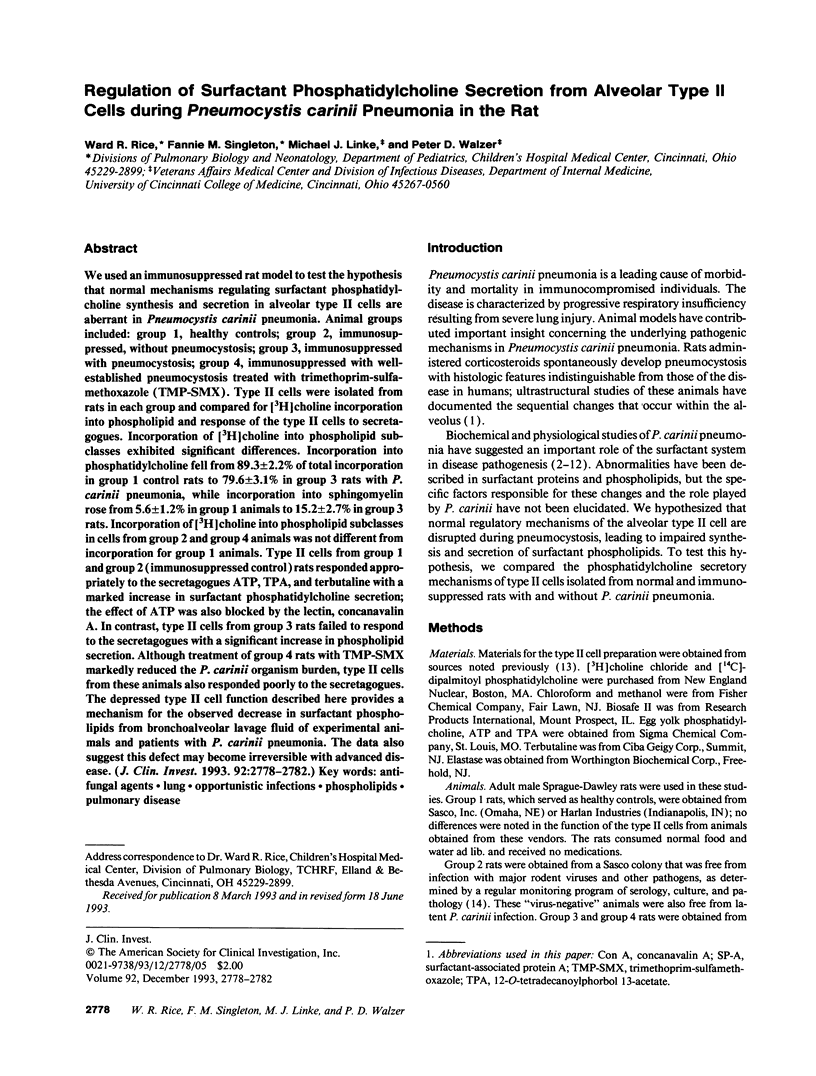
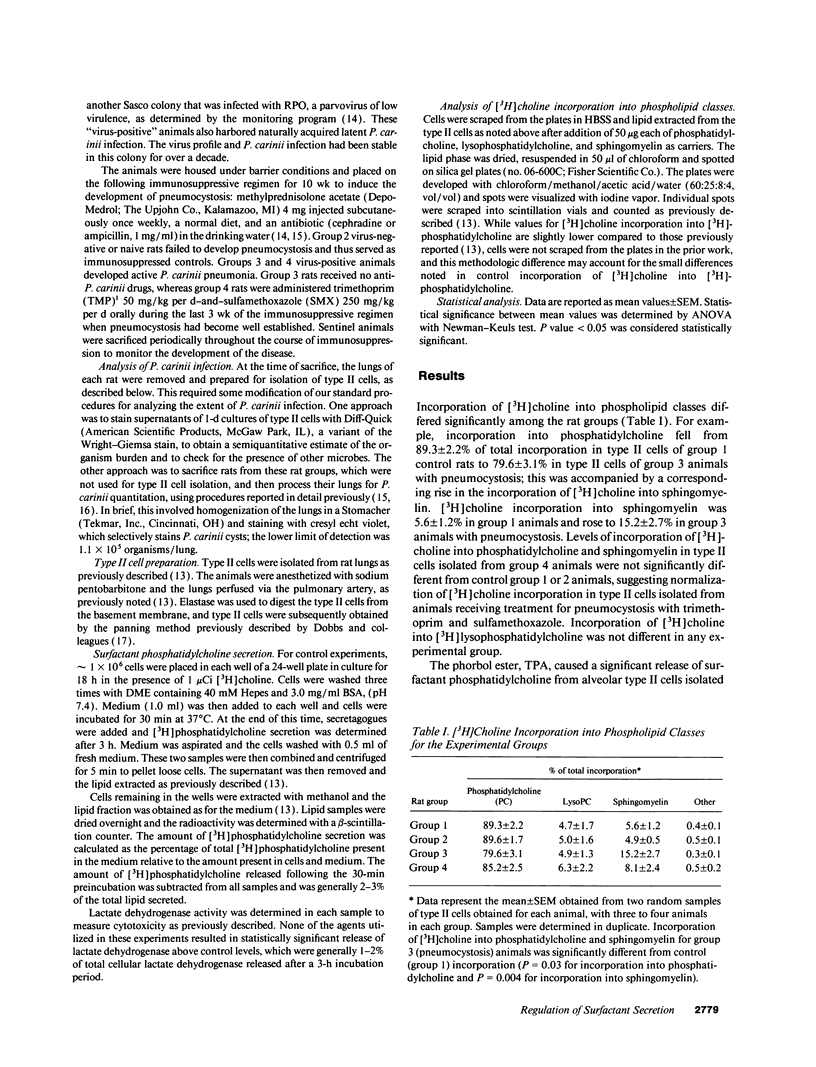
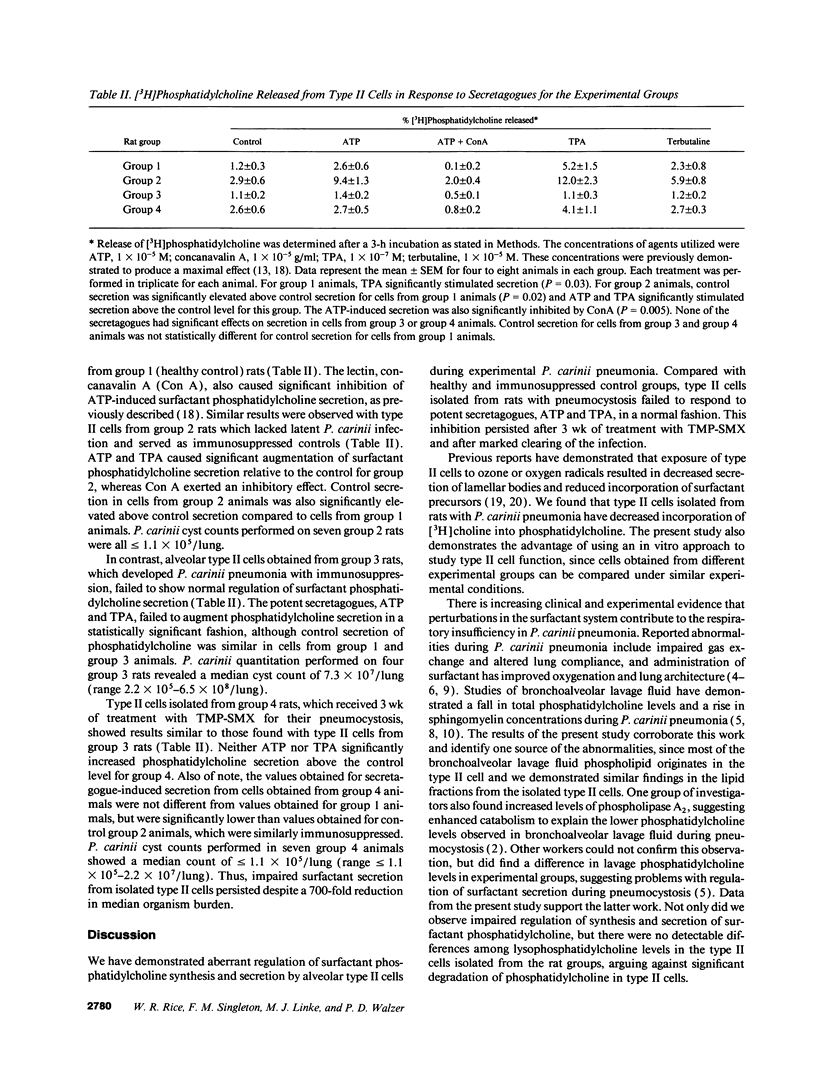
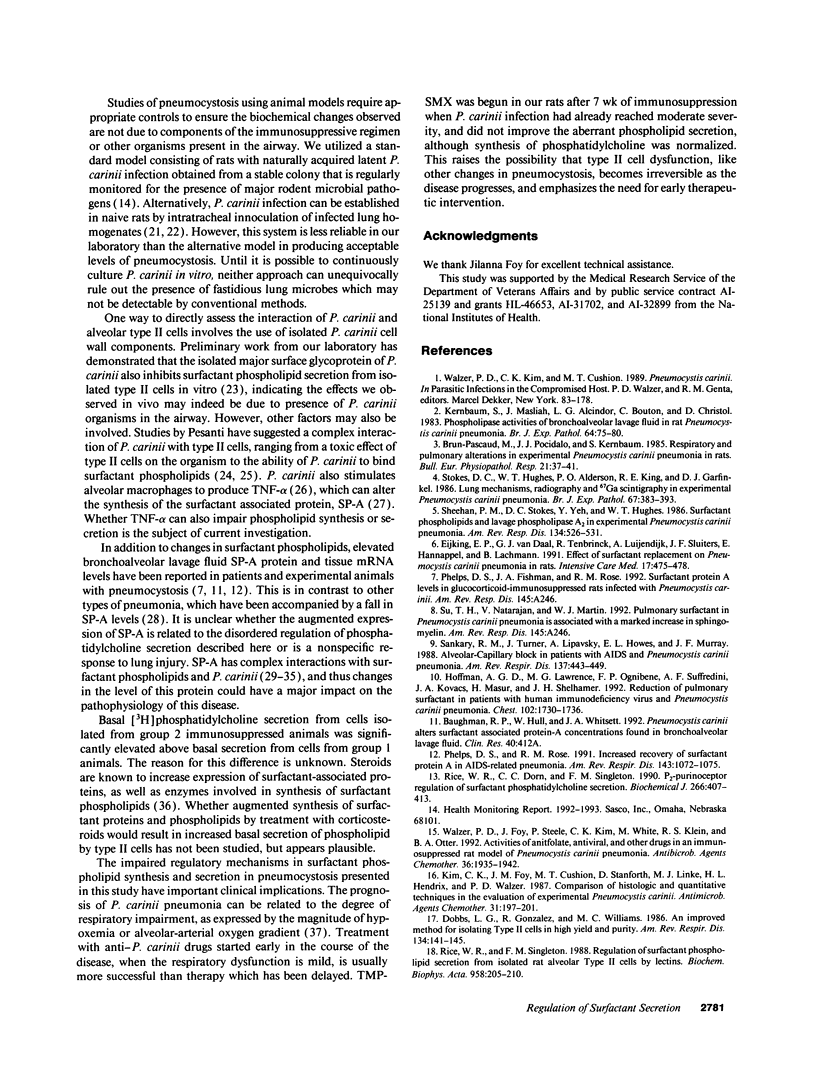
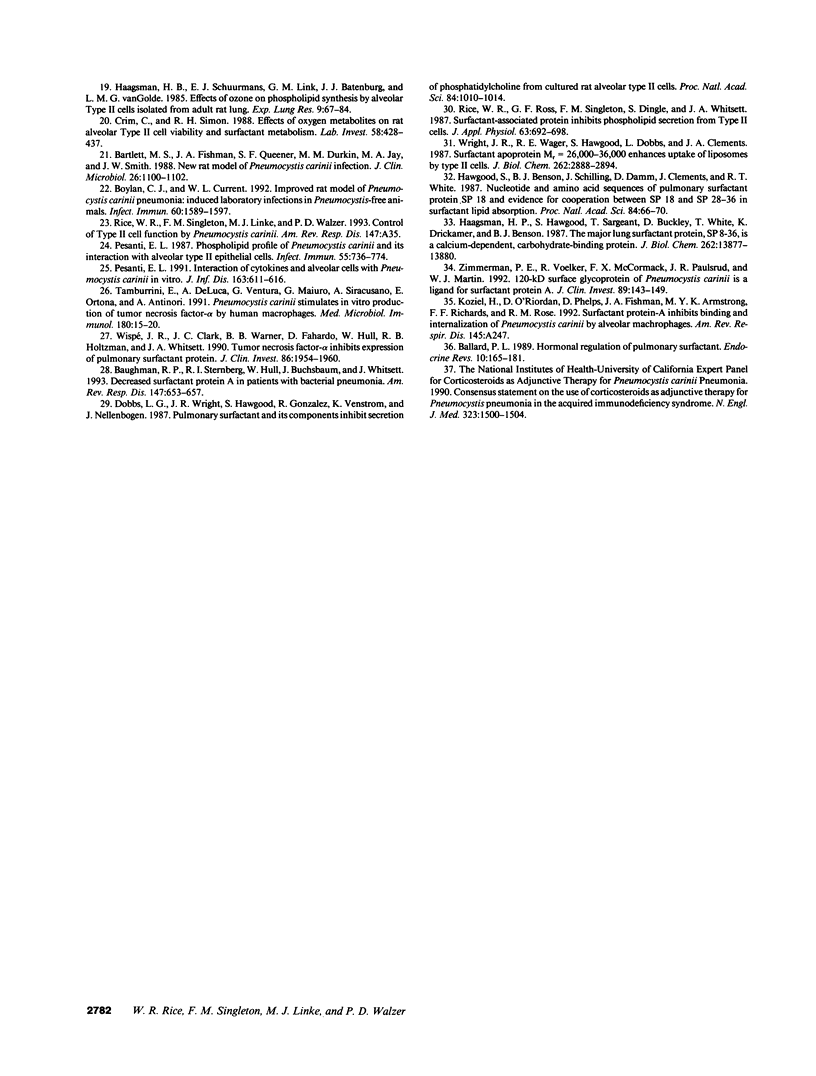
Selected References
These references are in PubMed. This may not be the complete list of references from this article.
- Ballard P. L. Hormonal regulation of pulmonary surfactant. Endocr Rev. 1989 May;10(2):165–181. doi: 10.1210/edrv-10-2-165. [DOI] [PubMed] [Google Scholar]
- Bartlett M. S., Fishman J. A., Queener S. F., Durkin M. M., Jay M. A., Smith J. W. New rat model of Pneumocystis carinii infection. J Clin Microbiol. 1988 Jun;26(6):1100–1102. doi: 10.1128/jcm.26.6.1100-1102.1988. [DOI] [PMC free article] [PubMed] [Google Scholar]
- Baughman R. P., Sternberg R. I., Hull W., Buchsbaum J. A., Whitsett J. Decreased surfactant protein A in patients with bacterial pneumonia. Am Rev Respir Dis. 1993 Mar;147(3):653–657. doi: 10.1164/ajrccm/147.3.653. [DOI] [PubMed] [Google Scholar]
- Boylan C. J., Current W. L. Improved rat model of Pneumocystis carinii pneumonia: induced laboratory infections in Pneumocystis-free animals. Infect Immun. 1992 Apr;60(4):1589–1597. doi: 10.1128/iai.60.4.1589-1597.1992. [DOI] [PMC free article] [PubMed] [Google Scholar]
- Brun-Pascaud M., Pocidalo J. J., Kernbaum S. Respiratory and pulmonary alterations in experimental Pneumocystis carinii pneumonia in rats. Bull Eur Physiopathol Respir. 1985 Jan-Feb;21(1):37–41. [PubMed] [Google Scholar]
- Crim C., Simon R. H. Effects of oxygen metabolites on rat alveolar type II cell viability and surfactant metabolism. Lab Invest. 1988 Apr;58(4):428–437. [PubMed] [Google Scholar]
- Dobbs L. G., Gonzalez R., Williams M. C. An improved method for isolating type II cells in high yield and purity. Am Rev Respir Dis. 1986 Jul;134(1):141–145. doi: 10.1164/arrd.1986.134.1.141. [DOI] [PubMed] [Google Scholar]
- Dobbs L. G., Wright J. R., Hawgood S., Gonzalez R., Venstrom K., Nellenbogen J. Pulmonary surfactant and its components inhibit secretion of phosphatidylcholine from cultured rat alveolar type II cells. Proc Natl Acad Sci U S A. 1987 Feb;84(4):1010–1014. doi: 10.1073/pnas.84.4.1010. [DOI] [PMC free article] [PubMed] [Google Scholar]
- Eijking E. P., van Daal G. J., Tenbrinck R., Luijendijk A., Sluiters J. F., Hannappel E., Lachmann B. Effect of surfactant replacement on Pneumocystis carinii pneumonia in rats. Intensive Care Med. 1991;17(8):475–478. doi: 10.1007/BF01690770. [DOI] [PubMed] [Google Scholar]
- Haagsman H. P., Hawgood S., Sargeant T., Buckley D., White R. T., Drickamer K., Benson B. J. The major lung surfactant protein, SP 28-36, is a calcium-dependent, carbohydrate-binding protein. J Biol Chem. 1987 Oct 15;262(29):13877–13880. [PubMed] [Google Scholar]
- Haagsman H. P., Schuurmans E. A., Alink G. M., Batenburg J. J., van Golde L. M. Effects of ozone on phospholipid synthesis by alveolar type II cells isolated from adult rat lung. Exp Lung Res. 1985;9(1-2):67–84. doi: 10.3109/01902148509061529. [DOI] [PubMed] [Google Scholar]
- Hawgood S., Benson B. J., Schilling J., Damm D., Clements J. A., White R. T. Nucleotide and amino acid sequences of pulmonary surfactant protein SP 18 and evidence for cooperation between SP 18 and SP 28-36 in surfactant lipid adsorption. Proc Natl Acad Sci U S A. 1987 Jan;84(1):66–70. doi: 10.1073/pnas.84.1.66. [DOI] [PMC free article] [PubMed] [Google Scholar]
- Hoffman A. G., Lawrence M. G., Ognibene F. P., Suffredini A. F., Lipschik G. Y., Kovacs J. A., Masur H., Shelhamer J. H. Reduction of pulmonary surfactant in patients with human immunodeficiency virus infection and Pneumocystis carinii pneumonia. Chest. 1992 Dec;102(6):1730–1736. doi: 10.1378/chest.102.6.1730. [DOI] [PubMed] [Google Scholar]
- Kernbaum S., Masliah J., Alcindor L. G., Bouton C., Christol D. Phospholipase activities of bronchoalveolar lavage fluid in rat Pneumocystis carinii pneumonia. Br J Exp Pathol. 1983 Feb;64(1):75–80. [PMC free article] [PubMed] [Google Scholar]
- Kim C. K., Foy J. M., Cushion M. T., Stanforth D., Linke M. J., Hendrix H. L., Walzer P. D. Comparison of histologic and quantitative techniques in evaluation of therapy for experimental Pneumocystis carinii pneumonia. Antimicrob Agents Chemother. 1987 Feb;31(2):197–201. doi: 10.1128/aac.31.2.197. [DOI] [PMC free article] [PubMed] [Google Scholar]
- Pesanti E. L. Interaction of cytokines and alveolar cells with Pneumocystis carinii in vitro. J Infect Dis. 1991 Mar;163(3):611–616. doi: 10.1093/infdis/163.3.611. [DOI] [PubMed] [Google Scholar]
- Pesanti E. L. Phospholipid profile of Pneumocystis carinii and its interaction with alveolar type II epithelial cells. Infect Immun. 1987 Mar;55(3):736–741. doi: 10.1128/iai.55.3.736-741.1987. [DOI] [PMC free article] [PubMed] [Google Scholar]
- Phelps D. S., Rose R. M. Increased recovery of surfactant protein A in AIDS-related pneumonia. Am Rev Respir Dis. 1991 May;143(5 Pt 1):1072–1075. doi: 10.1164/ajrccm/143.5_Pt_1.1072. [DOI] [PubMed] [Google Scholar]
- Rice W. R., Dorn C. C., Singleton F. M. P2-purinoceptor regulation of surfactant phosphatidylcholine secretion. Relative roles of calcium and protein kinase C. Biochem J. 1990 Mar 1;266(2):407–413. doi: 10.1042/bj2660407. [DOI] [PMC free article] [PubMed] [Google Scholar]
- Rice W. R., Ross G. F., Singleton F. M., Dingle S., Whitsett J. A. Surfactant-associated protein inhibits phospholipid secretion from type II cells. J Appl Physiol (1985) 1987 Aug;63(2):692–698. doi: 10.1152/jappl.1987.63.2.692. [DOI] [PubMed] [Google Scholar]
- Rice W. R., Singleton F. M. Regulation of surfactant phospholipid secretion from isolated rat alveolar type II cells by lectins. Biochim Biophys Acta. 1988 Feb 4;958(2):205–210. doi: 10.1016/0005-2760(88)90178-6. [DOI] [PubMed] [Google Scholar]
- Sankary R. M., Turner J., Lipavsky A., Howes E. L., Jr, Murray J. F. Alveolar-capillary block in patients with AIDS and Pneumocystis carinii pneumonia. Am Rev Respir Dis. 1988 Feb;137(2):443–449. doi: 10.1164/ajrccm/137.2.443. [DOI] [PubMed] [Google Scholar]
- Sheehan P. M., Stokes D. C., Yeh Y. Y., Hughes W. T. Surfactant phospholipids and lavage phospholipase A2 in experimental Pneumocystis carinii pneumonia. Am Rev Respir Dis. 1986 Sep;134(3):526–531. doi: 10.1164/arrd.1986.134.3.526. [DOI] [PubMed] [Google Scholar]
- Stokes D. C., Hughes W. T., Alderson P. O., King R. E., Garfinkel D. J. Lung mechanics, radiography and 67Ga scintigraphy in experimental Pneumocystis carinii pneumonia. Br J Exp Pathol. 1986 Jun;67(3):383–393. [PMC free article] [PubMed] [Google Scholar]
- Tamburrini E., De Luca A., Ventura G., Maiuro G., Siracusano A., Ortona E., Antinori A. Pneumocystis carinii stimulates in vitro production of tumor necrosis factor-alpha by human macrophages. Med Microbiol Immunol. 1991;180(1):15–20. doi: 10.1007/BF00191696. [DOI] [PubMed] [Google Scholar]
- Walzer P. D., Foy J., Steele P., Kim C. K., White M., Klein R. S., Otter B. A., Allegra C. Activities of antifolate, antiviral, and other drugs in an immunosuppressed rat model of Pneumocystis carinii pneumonia. Antimicrob Agents Chemother. 1992 Sep;36(9):1935–1942. doi: 10.1128/aac.36.9.1935. [DOI] [PMC free article] [PubMed] [Google Scholar]
- Wispé J. R., Clark J. C., Warner B. B., Fajardo D., Hull W. E., Holtzman R. B., Whitsett J. A. Tumor necrosis factor-alpha inhibits expression of pulmonary surfactant protein. J Clin Invest. 1990 Dec;86(6):1954–1960. doi: 10.1172/JCI114929. [DOI] [PMC free article] [PubMed] [Google Scholar]
- Wright J. R., Wager R. E., Hawgood S., Dobbs L., Clements J. A. Surfactant apoprotein Mr = 26,000-36,000 enhances uptake of liposomes by type II cells. J Biol Chem. 1987 Feb 25;262(6):2888–2894. [PubMed] [Google Scholar]
- Zimmerman P. E., Voelker D. R., McCormack F. X., Paulsrud J. R., Martin W. J., 2nd 120-kD surface glycoprotein of Pneumocystis carinii is a ligand for surfactant protein A. J Clin Invest. 1992 Jan;89(1):143–149. doi: 10.1172/JCI115554. [DOI] [PMC free article] [PubMed] [Google Scholar]


